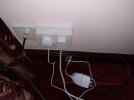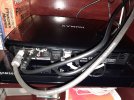-
 The forum software that supports hummy.tv has been upgraded to XenForo 2.3!
The forum software that supports hummy.tv has been upgraded to XenForo 2.3!
Please bear with us as we continue to tweak things, and feel free to post any questions, issues or suggestions in the upgrade thread.
You are using an out of date browser. It may not display this or other websites correctly.
You should upgrade or use an alternative browser.
You should upgrade or use an alternative browser.
5000T failed recordings
- Thread starter JennyT
- Start date
Yes it did.If that happened then everything would stop working altogether. Did that happen?
Not sure what he tested up the ladder. He tested the PSU inside the house and tested both the 5000T and the TV.Tested it where? Straight off the aerial? From the socket on the wall? At the input to the 5000 or the TV or both?
It's quite old - maybe 10-12 years at a guess. To be fair, he did ask us if we wanted it replacing but we asked his opinion. He said he had checked it and there wasn't any sign of water in it, so we decided to leave it. Probably the wrong decision.How old is the aerial?
No it doesn't. I'm not really sure where it could be fitted in the loft because we have rooms in the loft.Does it go in to the loft? The amp. would have been better placed inside where you can get to it
We are in the East Midlands (Derbyshire) but our strongest signal comes from Emley Moor (Yorks). The other two strong ones are Central and East Yorks & Linc but they aren't as strong. The aerial points towards Emley Moor, as do all our neighbours' aerials.Roughly where are you and which transmitter do you think you're using? Is it really the correct one or are you using a sub-optimal one for some reason? If you've got lots of 800+ channels then you're receiving reasonably well from at least two, although the masthead amp. is probably responsible for that.
The photos have been reduced in quality so much that they're not much use, but the one showing the back of the Humax is not great in terms of cabling.
Both aerial in and out seem very tight, as do all of them actually. You should aim to reduce the pulling tension on all of these otherwise you're just building up unreliability problems.
Sorry about the photos - they looked okay on my screen. I'll have another go at reducing them but not as much as last time.
My husband turned the Humax round so that he could get a better photo as it's difficult to get behind it. That's why the cables looked so tight but thank you for the advice.
Black Hole
May contain traces of nut
I couldn't see the dark coloured UHF leads until you mentioned it. Looked like some kind of plug to me, but I have been on the move.I don't know why BH couldn't work that out.
Agreed. To make sure, I have just read through the manual as well and there is no mention of it there either.I can’t find any antenna power settings on my 5000T so I think that’s a red herring.
prpr
Well-Known Member
OK. How are you verifying that you are actually tuned to Emley on the <800 channels rather than Belmont or Waltham?We are in the East Midlands (Derbyshire) but our strongest signal comes from Emley Moor (Yorks). The other two strong ones are Central and East Yorks & Linc but they aren't as strong. The aerial points towards Emley Moor, as do all our neighbours' aerials.
Much better.I'll have another go at reducing them but not as much as last time.
OK, thanks for clarifying.My husband turned the Humax round so that he could get a better photo as it's difficult to get behind it. That's why the cables looked so tight
EEPhil
Number 28
I had a thought about the PSU (assuming the small white box with 2 aerial cables and a mains connection is such a beast) but wanted to do some research before making a complete prat of myself!More interesting would be knowing what the amp. is, but as it's out of reach...
EEPhil
Number 28
In theory the 5000T asks you which region you want to tune to. I found,, when I could pick up Waltham, Belmont and Sutton Coldfield at my previous address, that it didn't always work properly. In any case BBC1, ITV1, ITV1+1 and the HD versions from other transmitters appeared in the 800s - confusing the recordings of those channels.Set a recording for LCN 1 (BBC1 EM) and end up recording BBC1 Yk&Li - a lower quality signal. I resort to a manual tune on Waltham. I suggest at some point JennyT does the same for Emley.OK. How are you verifying that you are actually tuned to Emley on the <800 channels rather than Belmont or Waltham?
Black Hole
May contain traces of nut
Yes, a manual tuning is a good step in areas where there are multiple possible sources. Instructions for HDR-FOX quoted below, which might be adaptable to 5000T:
However, now we have established the mast head amp is powered separately and the system looks like this:
...I still have no clue why the signal to the 5000T should degrade when the TV is off. Could it be HDMI emission, and that somehow with a non-responding TV the emission spectrum shifts to upset the UHF? The UHF cables look beefy enough though. What about the TV's internal PSU: maybe it is faulty and creating interference when on standby load.
Thus, if when you retune (Menu >> Settings >> Installation >> Automatic Search) you are asked to choose which region to use as your primary, and/or if once tuned you have any channels allocated to channel number 800, 801, 802 etc (where duplicates get loaded), you need to repeat the retuning using the manual method (Menu >> Settings >> Installation >> Manual Search). Instructions how to do this are HERE (click) - be sure not to have "Network Search" selected, and remember to select "DVB-T2" when scanning the HiDef multiplexes. You can just delete any channels which appear as 800+, but as there is a risk the wrong one might get deleted it is better to manage it via the tuning.
Further, even if there are no channels allocated in the 800s, it is still possible multiple relays within one region have been acquired - the services must all come from the same TV region, preferably the same transmitter. It is possible to check which broadcast channels your HD/HDR-FOX is currently tuned to: Menu >> Settings >> System >> Signal Detection >> > (right cursor) displays the full list (note these are broadcast channel numbers not LCNs, for explanation see the Glossary - click).
However, now we have established the mast head amp is powered separately and the system looks like this:
[Antenna] -> [Amp] -----------> [Amp PSU] ---> [5000T] ---> [TV]
...I still have no clue why the signal to the 5000T should degrade when the TV is off. Could it be HDMI emission, and that somehow with a non-responding TV the emission spectrum shifts to upset the UHF? The UHF cables look beefy enough though. What about the TV's internal PSU: maybe it is faulty and creating interference when on standby load.
EEPhil
Number 28
Pure speculation: I had the opposite problem with two Humaxes. Turn the second box on and the signal on one multiplex on the other box drops. Changing the positions of all the aerial cabling solved it - for a while. Fingers crossed it hasn’t happened at my new address. Could it be a similar “self-interference”?...I still have no clue why the signal to the 5000T should degrade when the TV is off.
At the risk of looking a fool, I was wondering about the PSU. Are both connectors of the same gender? If they are, are the connections the right way round?
I don't think it is the TV because we changed the TV at the same time as the 5000T, and we had a similar problem with the last 5000T. Incidentally, if we are watching Netflix on the TV (and therefore the 5000T is in standby mode) the recordings still fail. They only work when we are watching the TV through the 5000T.Yes, a manual tuning is a good step in areas where there are multiple possible sources. Instructions for HDR-FOX quoted below, which might be adaptable to 5000T:
However, now we have established the mast head amp is powered separately and the system looks like this:
[Antenna] -> [Amp] -----------> [Amp PSU] ---> [5000T] ---> [TV]
...I still have no clue why the signal to the 5000T should degrade when the TV is off. Could it be HDMI emission, and that somehow with a non-responding TV the emission spectrum shifts to upset the UHF? The UHF cables look beefy enough though. What about the TV's internal PSU: maybe it is faulty and creating interference when on standby load.
Last night I recorded the England match overnight just to test it and when I checked it out this morning it looked as though it had recorded correctly but later on in the game it failed (the picture broke up). This makes me think that it is somehow to do with the timespan, as it seems as though it recorded okay until a few hours after we had turned the TV off and gone to bed. I haven't had time to investigate this properly yet.
It does sound as though the aerial amplifier is somehow controlled by the TV.
It seems a long shot, especially as the 5000 is between it and the TV, but could this be a 'smart' device that turns itself off to save power?
Can't make out the name from the pictures, so what make and model is that aerial box in the first picture.
It seems a long shot, especially as the 5000 is between it and the TV, but could this be a 'smart' device that turns itself off to save power?
Can't make out the name from the pictures, so what make and model is that aerial box in the first picture.
EEPhil
Number 28
Argh! Save us from "smart" devices. If the aerial routing is -It seems a long shot, especially as the 5000 is between it and the TV, but could this be a 'smart' device that turns itself off to save power?
Aerial -> Masthead amplifier -> download cable -> wall socket -> PSU --> 5000T -> TV how is the PSU deciding to turn off? ESP with the TV?
Indeed. Would be useful to know this as I stated earlier - but for a different reason. If it is a smart device I wonder if it's possible to make it dumb.so what make and model is that aerial box in the first picture.
This is very curious.
There is some amazingly clever stuff around these days, so it wouldn't surprise me.ESP with the TV?
There could be some feature like CEC but using radio that, like power saving modes, is enabled by default.
"When you've eliminated the possible ..." as Sherlock might have said.
prpr
Well-Known Member
They're usually F types these days, both female. It wouldn't work at all if the cables were the wrong way round.At the risk of looking a fool, I was wondering about the PSU. Are both connectors of the same gender?
I think it's all just coincidence really and people are trying to pin conclusions to things in the absence of any better ideas. The TV is not powering the amp. via 2 other devices. Turn off the white PSU and see what happens.They only work when we are watching the TV through the 5000T.
Last night I recorded the England match overnight just to test it and when I checked it out this morning it looked as though it had recorded correctly but later on in the game it failed (the picture broke up). This makes me think that it is somehow to do with the timespan, as it seems as though it recorded okay until a few hours after we had turned the TV off and gone to bed.
I think the whole system is marginal for whatever reason. It's impossible for anyone to say, without being there and having some measuring gear, what the actual problem is (or problems are).
I still wonder why that socket is taped up and apparently has no screws. I still also wonder about the flylead between the socket and the 5000. Is it decent quality, is it made off properly (and the centre pins soldered - no, nobody bothers, but it does make a difference).
And the transmitter verification question still stands.
It has of course not been established which channels (and therefore which multiplexes from which transmitter - there may be a mix of ones tuned) are susceptible to the problem.
Black Hole
May contain traces of nut
No conclusions, just suggestions for further consideration. If reception is so marginal that changing the electromagnetic environment by turning off the TV upsets it, there's something seriously wrong somewhere.trying to pin conclusions to things in the absence of any better ideas
JennyT: you should find some tuning information somewhere (somebody with a 5000T will have to say where exactly) – what is the reported signal strength and quality for the channel in question, and what frequency?
These are manual tuning instructions for the FVP-5000T posted by Barry over at myhumax.org but heavily based on my HDR-FOX T2 manual tuning instructions.JennyT: you should find some tuning information somewhere (somebody with a 5000T will have to say where exactly) – what is the reported signal strength and quality for the channel in question, and what frequency?
1.Go to https://www.freeview.co.uk/freeview-channel-checker and input your postcode and house number. When the results appear click on the "Detailed transmitter view". Look carefully at the information returned for each transmitter; don't blindly accept the recommendation for the most likely transmitter.
2.Having decided on a transmitter,note down the six or seven channel numbers for the mutiplexes (shown in the column headed N and on a darker grey background). Carefully mark which one of these channel numbers are HD Muxes.
3. On the FVP Menu, Settings, Channel Settings.
4. Select Automatic search for channels and immediately stop it; save the results. This deletes all previously found channels.
5. Select Manual search. In the Channel field press right arrow, scroll up or down and select the first channel number from your list. In the Transmission field leave it on the default DVB-T for all channels except the HD channels; for the HD channels it must be changed to DVB-T2 (and for SD channels changed back to DVB-T). Press Search. This should find a number of channel names. Save the results.
6. Repeat the manual search for each channel previously noted.
7. You will then need to re-enter your schedule of recordings.
Black Hole
May contain traces of nut
Not what I meant but useful nonetheless. How do you get the signal strength and quality, and the transmission frequency, on the 5000T?These are manual tuning instructions for the FVP-5000T posted by Barry over at myhumax.org
Last edited:
You use the “F” button on the remote and at the top scroll to “Settings” which you select with OK.Not what I meant but useful nontheless. How do you get the signal strength and quality, and the transmission frequency, on the 5000T?
Scroll down to Channel Settings and select “Signal Test”.
That will display the Signal Strength and Quality for any tuners in use, along with the UHF channel number(s) and frequencies.
If you are not recording, it will only show one set of figures as the other two tuners are not in use, this is normal.
That will increase to a maximum of three if you are recording from other Mux from the one you are watching.
Last edited:
EEPhil
Number 28
You could, of course, be watching BBC1 and recording BBC2, BBC NEWS and BBC4 and would only be using one tuner. But the point is well made. Some people do complain that not all the tuners are working.If you are not recording, it will only show one set of figures as the other two tuners are not in use, this is normal.




